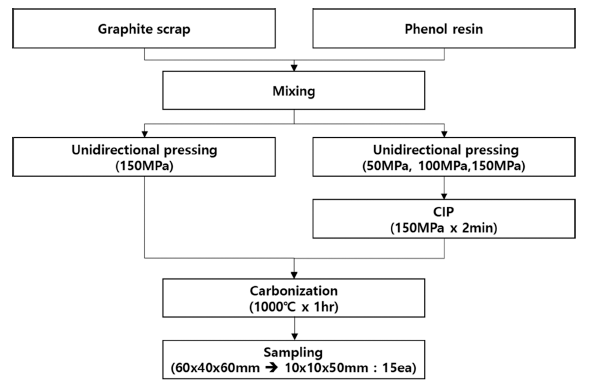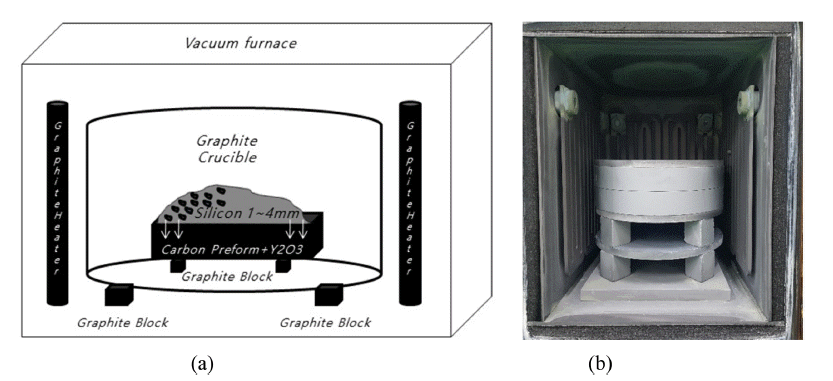Search
- Page Path
- HOME > Search
- [Korean]
- Changes in Mechanical and Electrical Properties as a Function of Unidirectional Pressure Changes in Preforming While Isostatic Pressing for Graphite Block Fabrication
- Tae-Sub Byun, Dong-Pyo Jeon, Sang-Hye Lee, Sang-Woo Lee, Jae-Seung Roh
- J Powder Mater. 2023;30(1):35-40. Published online February 1, 2023
- DOI: https://doi.org/10.4150/KPMI.2023.30.1.35

- 1,181 View
- 9 Download
- 2 Citations
-
 Abstract
Abstract
 PDF
PDF In this study, a graphite block is fabricated using artificial graphite processing byproduct and phenolic resin as raw materials. Mechanical and electrical property changes are confirmed due to the preforming method. After fabricating preforms at 50, 100, and 150 MPa, CIP molding at 150 MPa is followed by heat treatment to prepare a graphite block. 150UP-CIP shows a 12.9% reduction in porosity compared with the 150 MPa preform. As the porosity is decreased, the bulk density, flexural strength, and shore hardness are increased by 14.9%, 102.4%, and 13.7%, respectively; and the deviation of density and electrical resistivity are decreased by 51.9% and 34.1%, respectively. Therefore, as the preforming pressure increases, the porosity decreases, and the electrical and mechanical properties improve.
-
Citations
Citations to this article as recorded by- Effect of Microstructural Change under Pressure during Isostatic Pressing on Mechanical and Electrical Properties of Isotropic Carbon Blocks
Tae-Sub Byun, Sang-Hye Lee, Suk-Hwan Kim, Jae-Seung Roh
Materials.2024; 17(2): 387. CrossRef - Effect of Pressure and Holding Time during Compression Molding on Mechanical Properties and Microstructure of Coke-Pitch Carbon Blocks
Sun-Ung Gwon, Sang-Hye Lee, U-Sang Youn, Jae-Seung Roh
Applied Sciences.2024; 14(2): 772. CrossRef
- Effect of Microstructural Change under Pressure during Isostatic Pressing on Mechanical and Electrical Properties of Isotropic Carbon Blocks
- [Korean]
- RBSC Prepared by Si Melt Infiltration into the Y2O3 Added Carbon Preform
- Min-Ho Jang, Kyeong-Sik Cho
- J Korean Powder Metall Inst. 2021;28(1):51-58. Published online February 1, 2021
- DOI: https://doi.org/10.4150/KPMI.2021.28.1.51

- 939 View
- 11 Download
-
 Abstract
Abstract
 PDF
PDF The conversion of carbon preforms to dense SiC by liquid infiltration is a prospectively low-cost and reliable method of forming SiC-Si composites with complex shapes and high densities. Si powder was coated on top of a 2.0wt .% Y2O3-added carbon preform, and reaction bonded silicon carbide (RBSC) was prepared by infiltrating molten Si at 1,450°C for 1-8 h. Reactive sintering of the Y2O3-free carbon preform caused Si to be pushed to one side, thereby forming cracking defects. However, when prepared from the Y2O3-added carbon preform, a SiC-Si composite in which Si is homogeneously distributed in the SiC matrix without cracking can be produced. Using the Si + C → SiC reaction at 1,450°C, 3C and 6H SiC phases, crystalline Si, and Y2O3 were generated based on XRD analysis, without the appearance of graphite. The RBSC prepared from the Y2O3-added carbon preform was densified by increasing the density and decreasing the porosity as the holding time increased at 1,450°C. Dense RBSC, which was reaction sintered at 1,450°C for 4 h from the 2.0wt.% Y2O3-added carbon preform, had an apparent porosity of 0.11% and a relative density of 96.8%.
TOP
 kpmi
kpmi


 First
First Prev
Prev


